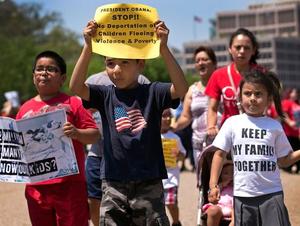ImmigrationWave of illegal children immigrants shifts debate on use of executive powers
After several immigration bills stalled in Congress, President Barack Obama, in 2012 and 2013, issued a series of executive orders to limit the number of deportations of illegal immigrants. Many who advocated a tougher stance on immigration have charged Obama with failure to consult with Congress. The Obama administration is now trying to find a way to deport Central American illegal immigrants, many of them unaccompanied children, without running afoul of a George W. Bush 2008 law which makes such deportation difficult – and some of his immigration criticswant him to take executive action on the issue, a shift from their usual criticism that he has abused his executive powers.

States brace for influx of border-crossing children // Source: gmu.edu
What was an attempt to improve America’s immigration policy and find an effective path to legal residency for illegal immigrants in the United States has turned to a debate on how to improve border security and quickly send migrants back to their country of origin, specifically Central American children from El Salvador, Honduras, and Guatemala.
In 2013 President Barack Obama asked Congress to support his plan to create a pathway to citizenship or legal residency for illegal immigrants, but most Republicans in Congress refused. Obama then issued a series of executive orders to help limit the number of deportations of illegal immigrants, and in response, many who advocated a tougher stance on immigration charged Obama with failure to consult with Congress.
Today, the Obama administration is focused on returning the majority of the Central American migrants on the Southwest border back to their home countries, and Republican lawmakers are urging prompt legislation to reduce the flow of illegal migrants coming into the United States. The Star Tribune notes that some Republicans even want Obama to take executive action on the issue, a shift from their usual criticism that Obama has abused his executive powers.
From 1990 to 2007, apprehensions by the Border Patrol of illegal border crossers averaged 1.17 million a year. Apprehensions had dropped to nearly 365,000 by 2012. The reduction has been attributed to stricter enforcement along the border, the U.S. economic downturn, and improved economic conditions in Mexico.
The recent influx of illegal migrants is largely of families with children or minors traveling alone. Immigration officials attribute most of the 57,000 unaccompanied children apprehended along the Southwest border between October 2013 and end of June 2014, to a 2008 law passed by former President George W. Bush, which gives a legal pathway for children seeking asylum in the United States due to harsh humanitarian conditions in their home country. Crime, gang violence, and poverty across Central America have also added to the influx of migrants.
Many House Republicans are now open to making changes to the 2008 Bush administration law, but several Democrats would like to keep the bill amid support from immigration advocates.
Obama has since requested $3.7 billion from Congress to increase the number of Health and Human Services facilities available to accommodate young migrants until they can be sent home or to relatives in the United States. The funds will also help increase the number of Border Patrol agents, and immigration judges to deal with pending asylum cases. House Speaker John Boehner (R-Ohio) noted last week that it is unlikely that Congress would agree on an immigration spending bill before the end of July, when lawmakers go on break.
